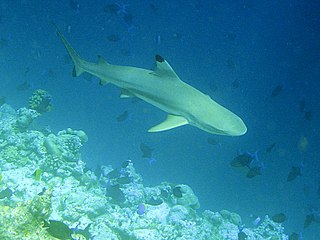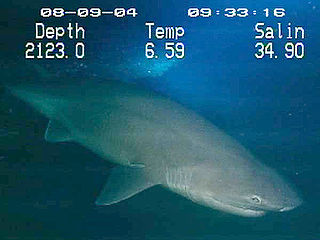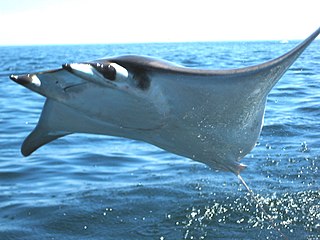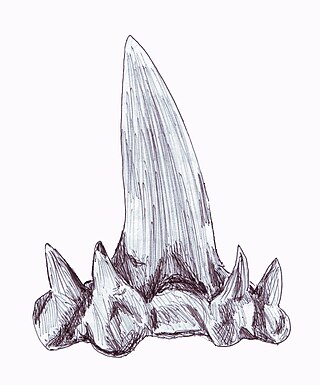Related Research Articles

Requiem sharks are sharks of the family Carcharhinidae in the order Carcharhiniformes. They are migratory, live-bearing sharks of warm seas and include such species as the bull shark, lemon shark, spinner shark, blacknose shark, blacktip shark, grey reef shark, blacktip reef shark, silky shark, dusky shark, blue shark, copper shark, oceanic whitetip shark, and whitetip reef shark.

The Hexanchiformes are the order consisting of the most primitive types of sharks, and numbering just seven extant species. Fossil sharks that were apparently very similar to modern sevengill species are known from Jurassic specimens.

The Lamniformes are an order of sharks commonly known as mackerel sharks. It includes some of the most familiar species of sharks, such as the great white, as well as more unusual representatives, such as the goblin shark and megamouth shark.

Cow sharks are a shark family, the Hexanchidae, characterized by an additional pair or pairs of gill slits. Its 37 species are placed within the 10 genera: Gladioserratus, Heptranchias, Hexanchus, Notidanodon, Notorynchus, Pachyhexanchus, Paraheptranchias, Pseudonotidanus, Welcommia, and Weltonia.

Squalicorax, commonly known as the crow shark, is a genus of extinct lamniform shark known to have lived during the Cretaceous period. The genus had a global distribution in the Late Cretaceous epoch. Multiple species within this genus are considered to be wastebasket taxon due to morphological similarities in the teeth.

Mobula is a genus of rays in the family Mobulidae that is found worldwide in tropical and warm, temperate seas. Some authorities consider this to be a subfamily of the Myliobatidae. Their appearance is similar to that of manta rays, which are in the same family, and based on genetic and morphological evidence, the mantas belong in Mobula. Species of this genus are often collectively referred to as "devil rays", "flying mobula", or simply "flying rays", due to their propensity for breaching, sometimes in a spectacular manner. These rays gather in groups and leap out of the surface into the air up to around two metres before splashing back into the water.

Ginglymostoma is a genus of shark in the family Ginglymostomatidae. There are two members in the genus. Members of this genus eat small fish and crustaceans, and are commonly quite lethargic unless provoked. Members of this genus have the ability to suck in water in order to remove snails from their shells in a manner that can be described as 'vacuum-like'.
Anomotodon is an extinct genus of shark related to the extant goblin shark. The distribution of Anomotodon fossils is worldwide, in formations indicating that members of the genus lived from the Early Cretaceous epoch through the Eocene epoch, and perhaps through the Oligocene as well. Described species include A. novus, A. plicatus, A. principalis, and A. multidenticula.
Gladioserratus is an extinct genus of cow shark. It contains three species:
Roulletia is an extinct genus of sand sharks. It was described by Romain Vullo, Henri Cappetta, and Didier Néraudeau in 2007, and the type species is R. bureaui, which existed during the upper Cenomanian of what is now France. The genus was named after its type locality, Roullet-Saint-Estèphe, while the species epithet honours Michel Bureau, an amateur paleontologist who gathered the material for the species. Another species, R. canadensis, was described from the Cenomanian of Canada by Charlie J. Underwood and Stephen L. Cumbaa in 2010. The species epithet refers to the country in which it was discovered. It has been suggested tentatively this genus may be related to Haimirichia, which has been placed in its own family (Haimirichiidae) based on soft-tissue preservation.
Welcommia is an extinct genus of shark. It contains only three species :-

Cretalamna is a genus of extinct otodontid shark that lived from the latest Early Cretaceous to Eocene epoch. It is considered by many to be the ancestor of the largest sharks to have ever lived, Otodus angustidens, Otodus chubutensis, and Otodus megalodon.

Pseudocorax is an extinct genus of mackerel sharks that lived during the Late Cretaceous. It contains six valid species that have been found in Europe, the Middle East, North Africa, and North America. It was formerly assigned to the family Anacoracidae, but is now placed in its own family Pseudocoracidae along with Galeocorax. The former species "P." australis and "P." primulus have been reidentified as species of Echinorhinus and Squalicorax, respectively.

Cladodont is the term for a common category of early Devonian shark known primarily for its "multi-cusped" tooth consisting of one long blade surrounded by many short, fork-like tines, designed to catch food that was swallowed whole, instead of being used to saw off chunks of meat like many modern sharks. The skinny teeth would puncture and grasp the prey, keeping it from wriggling free.

Synechodontiformes is an extinct order of prehistoric sharks, known from the Permian to the Paleogene. They are considered to be members of Neoselachii, the group that contains modern sharks and rays. Their placement in the group is uncertain, some authors have considered them to be galeomorph crown-group sharks, while others have considered them to represent a stem-group to modern sharks. They have sometimes been considered a paraphyletic grouping, but Klug (2010) recovered the group as monophyletic. Members of the clade are united by two synapomorphies, "pseudopolyaulacorhize tooth root pattern present; labial root depression in basal view present". The oldest possible member of the clade are teeth from the early Permian (Cisuralian) of the Ural Mountains.
Rolfodon bracheri is an extinct species from the family Chlamydoselachidae. It lived during the Miocene.
Rolfodon goliath is an extinct species of large frilled shark that lived during the Late Campanian stage of the Late Cretaceous in Angola's southern Benguela Basin. It was described by Miguel Telles Antunes and Henri Cappetta in 2002 during the beginning stages of the PaleoAngola project. Originally it was described as a species belonging to the genus Chlamydoselachus; Cappetta, Morrison & Adnet (2019) transferred it to the chlamydoselachid genus Rolfodon.
Adnetoscyllium is an extinct genus of bamboo shark from the Cretaceous period. It is currently monotypic, containing only the species A. angloparisensis. The genus is named for prominent paleoichthyologist, Dr. Sylvain Adnet. The specific epithet refers to the range which is thus far restricted to the Anglo-Paris Basin of France and the United Kingdom.
Archaeogaleus is an extinct genus of requiem shark from the Cretaceous period. It is known only from the species A. lengadocensis. It was described from the Valanginian stage of France. The specific epithet refers to Lengadòc, the region where Occitan was historically spoken. It is the oldest known requiem shark and has a presumed dentition similar to the modern form Scoliodon.
Antrigoulia is an extinct genus of palaeospinacid shark from the Cretaceous period. It is named after a farm in the vicinity of the type locality called Mas d’Antrigoule. It is known from a single species consisting of isolated teeth from the Valanginian of France, A. circumplicata. The name is derived from the concentric folds on the labial side of its teeth.
References
- H. Cappetta, Handbook of Paleoichthyology (Gustav Fischer, 1987)